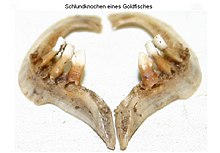Pharynx

Mouth teeth are found in most types of bony fish , for example in all carp-like species and cichlids . They stand on the pharyngeal bones, which are derived from gill arches (see Pharyngealia ). In the carp fish, the pharynx teeth stand on two arched pharyngeal bones, in the cichlid on a Y-shaped lower pharynx and two rounded upper pharyngeal bones.

Depending on the specialization in different foods, the shape and number of fangs vary. Due to their characteristic shape, number and arrangement, mouth teeth can often be used to identify and differentiate between different types of fish. In carp fish, formulas can be used to record the number and position of the pharyngeal teeth per row of teeth. The pharynx teeth of the carp fish interlock like the teeth of a gear wheel and also against a tooth or horn plate ( carp stone ) just in front of the esophagus at the upper end of the pharyngeal arch. In the loaches, this horn plate is replaced by a rough horn surface or by tough mucous membranes. In the cichlids there are two more toothed bones opposite the gullet teeth.
Some fish, e.g. B. the grunts , also use the fangs to make sounds. The sounds are created by rubbing the gullet teeth together.